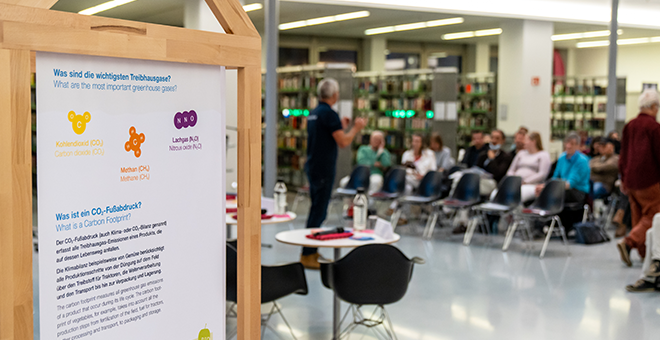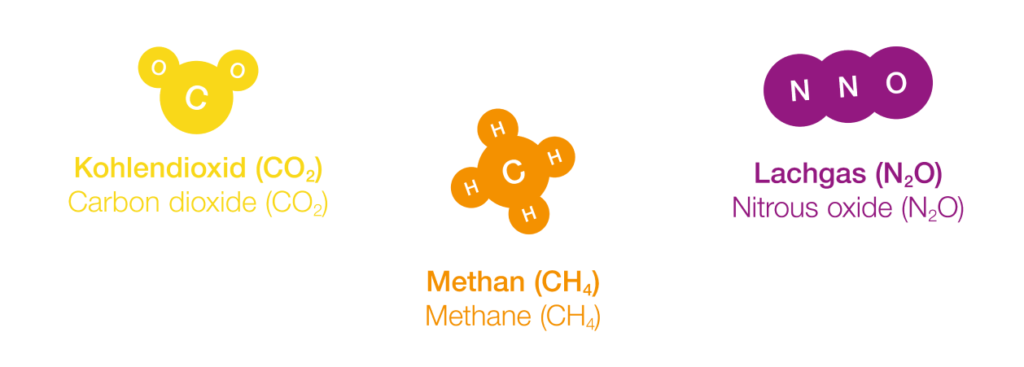
Was ist ein CO2-Fußabdruck?
Der CO2-Fußabdruck (auch Klima- oder CO2-Bilanz genannt) erfasst alle Treibhausgas-Emissionen eines Produkts, die auf dessen Lebensweg anfallen. Die Klimabilanz beispielsweise von Gemüse berücksichtigt alle Produktionsschritte von der Düngung auf dem Feld über den Treibstoff für Traktoren, die Weiterverarbeitung und den Transport bis hin zur Verpackung und Lagerung.
Die wichtigsten Treibhausgase sind:

Kohlendioxid (CO2), Methan (CH4), Lachgas (N2O)
CO2-Äquivalente
Der Begriff CO2-Äquivalent fasst die verschiedenen Treibhausgase zu einer Maßeinheit zusammen. Jedes Gas hat ein anderes Potential, zur globalen Erwärmung beizutragen. Die Berechnung ermittelt die Erwärmungswirkung eines Treibhausgases über einen festgelegten Zeitraum (meist 100 Jahre) und stellt sie in Beziehung zu der von CO2. Demnach hat Methan die 28-fache und Lachgas die 265-fache Treibhausgaswirkung von CO2.
Bio ist besser!
Der ökologische Landbau ist eine besonders ressourcenschonende und umweltverträgliche Form der Landwirtschaft. Diese Produktionsweise vermeidet den Einsatz von Stickstoff- Mineraldünger, dessen Herstellung viel Energie benötigt und beim Einsatz Lachgas freisetzt. Durch ihren hohen Humusanteil binden Bio-Äcker mehr CO2 als konventionelle Äcker. Die ökologische Landwirtschaft vermeidet Futtermittel aus Soja, dessen Produktion u.a. die Zerstörung des Regenwaldes – ein wichtiger Speicher von CO2 – vorantreibt. Aus diesem Grund haben frische Bioprodukte im Schnitt eine 15 % bessere CO2-Bilanz als herkömmliche.
What is a Carbon Footprint?
The carbon footprint measures all greenhouse gas emissions of a product that occur during its life cycle. The carbon footprint of vegetables, for example, takes into account all the production steps from fertilization of the field, fuel for tractors, further processing and transport, to packaging and storage.
The most important greenhouse gases are:

Carbon dioxide (CO2), Methane (CH4), Nitrous oxide (N2O)
CO2-Equivalents
The term CO2 equivalent combines the various greenhouse gases into one unit of measurement. Each gas has a different potential to contribute to global warming. The calculation determines the warming effect of a greenhouse gas over a fixed period of time (usually 100 years) and relates it to that of CO2. This results in a value of 28 times the greenhouse gas effect of CO2 for methane and 265 times for nitrous oxide. (Source: IPCC Fifth Assessment Report (AR5))
Organic is the better choice!
Organic farming is a particularly resource-efficient and environmentally compatible form of agriculture. This production method avoids the use of nitrogen mineral fertilizers, the production of which requires a lot of energy and releases nitrous oxide when used. Due to their high humus content, organic fields bind more CO2 than conventional fields. Organic farming avoids feed made from soy, the production of which causes, among other things, the destruction of the rainforest – an important reservoir of CO2. For this reason, fresh organic products have on average a 15% better carbon footprint than conventional products.




